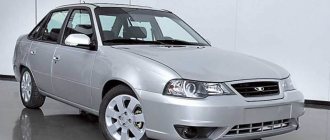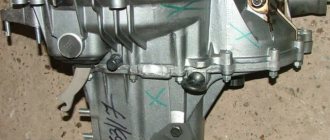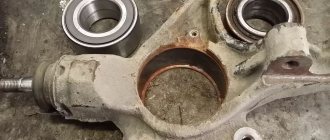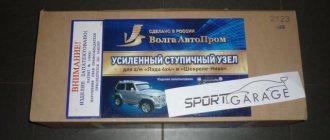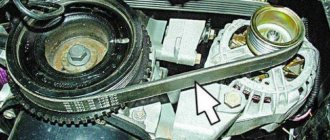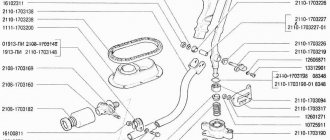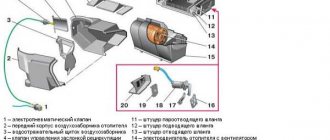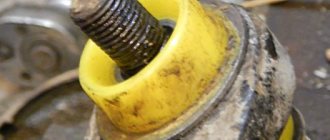Wheel bearings on domestically produced cars wear out quickly. Replacing bearings on both the front and rear hubs is not an easy task, but it can be done. We will tell you how to independently replace the bearing on the front hub of a VAZ 2109 in this article.
- 2 When to replace the front wheel bearing
2.1 What leads to rapid wear
- 3.1 Required tools
3.1.1 Toolkit in the photo
What is a wheel bearing
The wheel bearing is the most important part of a car. Its main task is to ensure smooth and uniform rotation of the wheel. It acts as a connecting link between the car axle and the hub (to which the brake discs and wheel are attached using studs). It is impossible to see the wheel bearing from the outside. To get to it, you will have to remove the so-called rotary cam from the car, inside of which this bearing is located.
External view of the wheel bearing of a VAZ 2109 car
Wheel bearing location diagram for VAZ 2109
Bearing designs may vary. They come in both ball and roller types (this depends on both the brand of the bearing and the car manufacturer). Since the article is about the VAZ 2109 car, the car owner will have to deal with closed-type double-row wheel ball bearings, better known as HUB-1. They are used on almost all “nines”, and the reliability of these bearings leaves much to be desired.
Preparatory activities before replacement
Regardless of the chosen replacement option, you will need a minimum set of tools:
- Large screwdriver.
- Keys: 17, 13, 10.
- Hexagon 10.
- Hammer and chisel.
- A long 30mm wrench or a 30mm socket with a knob.
- Wheel puller for VAZ (photo).
- Mandrels (or heads) for knocking out the old part from the hub.
- Torque wrench.
We prepare the car, place it on a flat surface, you will also need bright lighting. You will complete all the work faster with an assistant, and also if you use an inspection hole (overpass). Put the car in first gear, and be sure to put chocks under the rear wheels.
Advice: The first, more efficient and high-quality replacement option is recommended for work, since pressing in and out is done using a removable device, in a shock-free manner.
Tools and materials for work
- Wheel chocks;
- Socket head for nine, thirteen, fifteen, nineteen, thirty;
- Power wrench;
- Jack;
- Wheel bolt wrench;
- Car stand;
- Nineteen spanner;
- Penetrating lubricant;
- Ratchet driver;
- Kardanchik;
- Extension;
- Pliers;
- Vise;
- Torque wrench;
- Extensions for dismantling and installing bearings;
- Hammer;
- Deep head for seven;
- Slotted screwdriver;
- Rubber hammer;
- Bulgarian;
- Chisel;
- Circlip pliers;
- Lithium grease.
This is interesting: Replacing the Ford Focus 2 generator with your own hands - how to remove and install a new one
Sequencing
- First of all, the car should be in first gear, after which the car is put on the handbrake. Wheel chocks must be placed under the rear wheels.
- The car is jacked up, the wheel, in the hub of which the bearing is damaged, is removed.
The car is on a jack, the wheel is removed, the hub is visible
- Use a 30 mm socket wrench to unscrew the wheel bearing nut.
The nut is unscrewed with a 30mm head
- Using a flat screwdriver, pry up the caliper, then it should be unscrewed from the steering knuckle (for this, use a 17 mm spanner).
- The unscrewed caliper should be tied with something (otherwise it will hang on the brake hose and this hose may come off under its weight). You should also unscrew the brake disc from the hub.
- Now you need to remove the wheel bearing itself. To get to it, you must first remove the steering knuckle, which will require unscrewing a couple of bolts that secure the knuckle to the car's ball joint.
Use a spanner to unscrew the ball joint bolts
- Using an attachment of a suitable diameter (you can use a piece of steel pipe of the required diameter as this attachment), you should knock the hub out of the bearing, after which you need to remove the retaining ring (pliers are excellent for removing the retaining ring).
It is better to knock out the hub with a pipe of suitable diameter
The best way to remove the ring is with pliers.
- Now you need to press out the bearing. This is done using a puller pre-clamped in a vice.
Pressing out the bearing with a puller
The bearing was successfully pressed out by the puller
- After pressing out the bearing, the place where it was located must be thoroughly cleaned of rust and dirt, and then lubricated.
- The new wheel bearing is pressed into the steering knuckle using a vice and a puller, and the retaining ring is installed in place.
- The knuckle with the new bearing is screwed back to the ball joint, the unit is reassembled, and the wheel is installed in place.
When should you replace the front wheel bearing?
It should be said right away that the bearings on both the front and rear hubs of the VAZ 2109 do not have a strictly specified service life. If we take the average data provided by the car owners themselves, it turns out that a new domestically produced wheel bearing can successfully travel up to 100,000 kilometers. After this number, problems may begin.
What leads to rapid wear
- Bad roads. When driving on a bad road, wheel bearings are subjected not only to frictional forces, but also to huge shock loads. For some time, the bearing successfully copes with all this, but then so-called “metal fatigue” may occur, which will lead to the rapid destruction of this part.
- Overheat. During operation, the bearing either heats up or cools down. Such temperature changes are harmful for any part, but in our country they are also aggravated by the climate (regular heating and sudden cooling in the cold of 40 degrees is clearly not good for bearings).
- Aggressive environment. This means that moisture, dirt, and chemicals that are sprinkled on roads sometimes get into the hub. Dirt and sand can act as an abrasive, and moisture and chemicals can cause corrosion.
There is only one result: premature wear. The main sign that it is time to change the bearings is a characteristic low hum that occurs in the wheel area while the car is moving. And the higher the speed of the car, the louder the hum.
At first, when the bearing is not yet very worn, this hum is practically inaudible; it appears and then disappears. But as it wears out, it develops into a real howl that is hard not to hear. If the bearing has already “howled”, this means only one thing: it needs to be changed urgently. If this is not done, the wheel will simply jam. And if this happens while driving at high speed, the car will definitely skid, which, in turn, will lead to an accident.
Replacement
Having selected the set of front wheel bearings required for replacement, you can get to work.
For repairs, in addition to the standard set of tools, you will need special bearing mandrels. If they are not available, you can use a pipe of suitable diameter.
Dismantling works
By following the instructions and relying on video lessons, you can replace the front wheel bearing with your own hands.
- Loosen the tension of the wheel bolts, remove the decorative plastic plug from the hub bearing and loosen the fastening nut.
- Using a socket and lever, loosen the bearing mounting nut.
- Raise the car with a jack, and then remove the wheels from the part of the front of the VAZ 2109 where you plan to replace the bearing.
- Remove anything that might prevent you from removing the hub. These objects include the brake disc, fastening to the steering knuckle, ball joint, steering knuckle mounting bolts, and front strut fasteners. Dismantle it all and move on.
- Completely unscrew the front hub nut, remove it and remove the thrust washer.
- It is necessary to remove the hubs from the front strut bracket and remove it.
- The hub has been dismantled, so you can press the damaged bearing out of it and put a serviceable unit in its place.
- Place the hub in a vise or in any other way convenient for you.
- Using a drift that fits the diameter, press the hub out of the inner race of the bearing.
- In some cases, the outer part of the inner ring may remain on the hub. In such a situation, you cannot do without a puller. In general, it is better to work with a special tool. It will probably be found among your friends or neighbors in the garage.
- Using the same drift, you need to remove the bearing from the steering knuckle. To do this work, you will have to remove the retaining rings in advance. They can be removed with any available tool, such as an awl. Although there are special clamps for such purposes.
This is interesting: Repair and replacement of the gear motor of the VAZ-2110 stove: practical recommendations
Accuracy is paramount
- That's it, you managed to remove the hub bearing.
- Carefully treat all dismantled parts using clean kerosene. Follow fire safety regulations.
- Assess the condition of the hub itself. If there are signs of damage, defects, or chips on it, it should be replaced with a new one.
- The new bearing is installed in place using a vice or press. In this case, force must be applied to the outer rings.
- Using a tool such as a hammer to drive in a bearing is strictly prohibited, as this will lead to destruction of the new part.
- After installing the front wheel bearing, perform the reassembly procedure
- Don't forget to change the hub nut.
- Once the assembly is fully assembled and the vehicle is lowered to the ground, only then should the mounting nuts be fully tightened.
Repairing the front hub when the bearing wears out or breaks is not as difficult as it might seem at first glance. Our instructions, supplemented by video tutorials, will help you complete the process yourself from start to finish.
Replacement with the rack not removed
This method will allow you to avoid subsequent collapse. Here you need to remove:
- wheel together with disk;
- caliper and the hub itself.
Replacement is carried out directly on the car, without removing the rack. Here you will have to work with a puller. The procedure is performed like this:
- unscrew the bolts from the brake drum and remove it;
- remove the ball joints;
- pull out the CV joint from the front hub, and then remove it itself using a chisel;
- the retaining ring is pulled out from the steering knuckle (it contains the outer part of the damaged bearing);
- the puller is installed directly on the fist;
- by tightening the bolt of the device, the part is pressed out;
When it completely leaves the axle, the protection is dismantled, then the hub is removed, from which the inner race is removed.
You can also remove the latter without a puller, but you will need a chisel for this. It’s also quite easy to score with a grinder and then split with a heavy hammer.
Installation
The inner surface of the fist is cleaned of dirt and lubricant (solid oil) is applied to it. The puller with the new bearing is installed in place and pressed into place. To make the process easier, it is recommended to first cool it thoroughly in the freezer.
A working unit is inserted into the fist as evenly as possible, trying to avoid distortion. After installing the bearing, put the hub back on and press it in if necessary. All other stages of work are carried out in reverse order.
The hub nut must be tightened using a torque wrench (the required force is 20 N*M).
Replacement without a puller with dismantling the rack
In this case, the entire structure must be completely removed from the car, including the steering knuckle. Replacement of a part that has become unusable is carried out directly at the rack. The advantage of this method is that there is no need to subsequently deal with wheel alignment.
All work is carried out in the following order:
- the steering tip is removed;
- the upper bolts holding the rack are unscrewed (they are located in the engine compartment);
- then it is removed from the CV joint and pulled out of the car.
The bearing is replaced and the strut is mounted in place.
Replacement without dismantling the stand and puller
In this case, it is necessary to remove the entire rotating mechanism with the hub installed.
Then she is knocked out. Upon completion of the work, you will have to check the wheel alignment. The sequence of actions here looks like this:
- the caliper is removed;
- the bolts securing the rack are screwed together;
- the rotating mechanism is removed;
- the CV joint is then removed;
- the drum is twisted from the hub;
- dismantle the protection;
- the fist, freed from other elements, is secured in a vice;
- the hub is knocked out, and then the bearing is removed.
Sources
- https://motorltd.ru/menyaem-perednij-stupichnyj-podshipnik-vaz-2109-svoimi-rukami/
- https://luxvaz.ru/vaz-2109/292-kak-pomenyat-stupichnyy-podshipnik.html
- https://zamena-podshipnikov.ru/zamena-perednego-stupichnogo-podshipnika-vaz-2109.html
- https://autorn.ru/vaz/2108/459-zamena-stupichnogo-podshipnika-vaz-2108-2109-21099.html
- https://ladaautos.ru/vaz-2109/zamena-perednego-stupichnogo-podshipnika-vaz-2109.html
[collapse]
